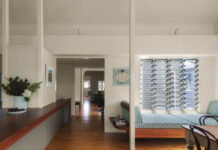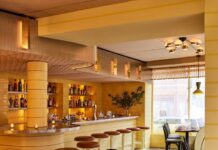[ad_1]
A Ceramics Studio Nestled Into The Bronte Hills
Studio Visit

The circular window in this outdoor studio creates another connection to the site. Photo – Saskia Wilson.

The window is both a portal into and out of the workspace. Photo – Saskia Wilson.

Dappled light streams into the space, covering Kati’s garden-facing seat in filtered sun. Photo – Saskia Wilson.

The studio is soft and meditative, perfect for creating Kati’s organic clay forms. Photo – Saskia Wilson.

The studio is like an outdoor room, replete with a roof garden. Photo – Saskia Wilson.

‘I like my work to have a good “hand feel”, to have a human scale, a sense of peace,’ says Kati. Left: Photo – Saskia Wilson. Right: Photo – Allana McAfee from Utopia Art Sydney.

It was essential to retain the garden, which has been Kati’s pride and joy since moving in 30 years ago. She shares the home with her partner, Shaun. Photo – Saskia Wilson.

Kati makes functional forms but with an organic style that exude a sense of human touch. Photo – Saskia Wilson.

‘I love the feel of a bowl in my hands. Bowls have a very human scale. They have a lovely lift. They are an archetypal form. They are useful,’ says Kati. Photo – Saskia Wilson.

Once finished, the porcelain and stoneware pieces are painted with gestural, intuitive marks. Photo – Saskia Wilson.
Kati Watson has been officially potting for 17 years, first learning ceramic skills at Bondi Pavilion in the mid-90s. Though she doesn’t practice full-time, last year’s lockdowns upped her time commitment to her stoneware and porcelain pieces, and she decided to engage SAHA architects to design a modest studio at the bottom of her jungle-like Bronte garden.
‘A verdant garden weaves its way around the site, shielding their home from view and casting long afternoon shadows,’ explains architect, Harry Catterns. ‘By raising a garden bed up as a green roof, Kati’s new ceramics studio disappears under coastal rosemary and grevilleas.’
It was essential that the garden was not compromised, so the architects devised an outdoor room design that would not impinge on the existing flora. In fact, it would frame it! Raw materials reflect the natural palette, and a roof garden introduces new plants directly into the design with banksia, tea tree, pig face, westringia and ficinia nodosa that resembles a coastal heath.
‘We wanted a design that was both sold and recessive; a continuation of the landscape and an elegant backdrop to their lives,’ adds Harry.
Connection to landscape was essential for Kati’s creative process, which is highly intuitive and responsive to nature. She paints her functional forms – largely bowls and jugs with gestural marks inspired by the spontaneity of the garden right outside her studio.
‘It is small but feels large and comfortable with a great sense of space,’ she says. ‘I can hear birds and children, and our dogs lie near me finding the best place to sunbake.’
This special spot is a slice of pure heaven.
[ad_2]
thedesignfiles.net










